
 | ||||||||||||||||||||||||||||||
| ||||||||||||||||||||||||||||||
TOUCHWOOD
Article: Sow Simple
in Cottage Garden Society Magasine, Autumn 2005
Sow simple!
Well, I believe sowing seeds IS simple and so rewarding. When I see pots of seed germinate it always gives me a thrill although I sow hundreds of types of seed each year. My excitement knows no bounds: you’d think I’d accomplished it all on my own without the considerable input from the seeds, nature and God! And yet……is it really that simple? Consider this truth: each and every type of seed needs exactly the right conditions in which to germinate. That includes variables such as correct amount of light as well as day-length, moisture levels, suitable substrate, and oxygen. Then there’s the demand of certain temperatures which includes not just required minimum or maximum temperatures, but also day/night fluctuation ranges! Then there’s certain seeds that have built-in delays to germination (so that the seed doesn’t germinate at the ‘wrong’ season in the wild), and the sower needs to break such dormancy before germination can occur. For example some alpines may need germination inhibitors washed out by rain (or watering). Interestingly a powerful germination inhibitor is contained in the gel around each tomato seed….that’s why it’s important to rinse and rub tomato seeds in a sieve and remove the coating before drying to send to any
seed exchanges. Tree seeds (and others) often have hard coverings, that can prevent water being absorbed to start the germination process….best to ‘scarify’ these. This means breaking the hard coat…..my preferred method involves holding the seed between thumb and forefinger and using a serrated kitchen knife. Others swear by rubbing between sheets of sandpaper, or nicking with nail clippers. There’s also the need in some plants to experience ‘winter’ before they germinate…so they need to be sown in autumn/winter and allowed to experience the freezing conditions. You can fool them by giving them about 6 weeks in the fridge (in damp sand, or sown in pots) before placing in normal place. With all those exacting special requirements it seems a wonder that anything ever germinates!
And yet again, here’s another truth: seeds WANT to germinate! They’re on your side…their whole reason for being is to germinate and develop into a plant, all you need do is offer approximately the right combination of conditions, leave them to it for a time and hey presto….all your own work….sort of! Most of the hardy plants on the CGS seed-list will respond to this treatment: Sow on surface of any (bought, hence ‘sterile’) compost, (preferably use a specialised sowing compost, yet I usually use growbag compost….cheap and easy to carry). Cover with roughly their own depth of compost, or grit, or vermiculite etc. Water before or after sowing. Leave outside/in greenhouse or cold-frame and wait. When? Start from autumn/winter for alpines and trees. Most hardy annuals and perennials will be happy sown from January to May, depending on their requirements, whereas biennials can be sown April-July as they’ll still have time for enough growth before the next year for flowering. Many plants can even be sown directly where they are to flower (annuals) or in nursery rows (vegetables, biennials and perennials) rather than in pots. Yes, there are some things that have more exacting requirements, primulas tend to want no covering of their seeds (so beware of them drying out!); some lettuce don’t like high temperatures; parsley, parsnips and other umbellifers have short viability of the seed, so you need f resh rather than seed stored from last year’s packet, and hellebores need sowing when first ripe (June) so they germinate the next spring (rather than sowing in the spring when they may take over a year as dormancy deepens if they don’t have the required ‘summer warmth then winter’s cold’ to trigger germination). I have a good rule of thumb concerning tricky items: sow a couple of years and fail, get upset about the cost of seeds that fail, and finally resort to looking their germination requirements up in a book! Tardy pragmatism! The RHS send out a germination guide if you order seeds from their gardens, and that’s a great reference guide.
resh rather than seed stored from last year’s packet, and hellebores need sowing when first ripe (June) so they germinate the next spring (rather than sowing in the spring when they may take over a year as dormancy deepens if they don’t have the required ‘summer warmth then winter’s cold’ to trigger germination). I have a good rule of thumb concerning tricky items: sow a couple of years and fail, get upset about the cost of seeds that fail, and finally resort to looking their germination requirements up in a book! Tardy pragmatism! The RHS send out a germination guide if you order seeds from their gardens, and that’s a great reference guide.
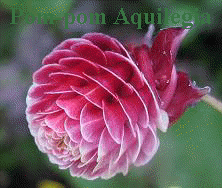 OK, let’s now look at some practical examples. Firstly God’s gift of a flower: aquilegias (granny’s bonnet’s/columbines). OK,
OK, let’s now look at some practical examples. Firstly God’s gift of a flower: aquilegias (granny’s bonnet’s/columbines). OK,
I’m biased! Well, I am obsessed by them and have a National Plant Collection here in
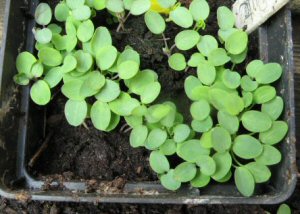 sown ten days later (on 2nd Feb) generally came up about the same date, taking only an average of 7 weeks 2 days. Those sown a further 3 weeks later again (20th Feb) were slightly quicker again at 6 weeks 3 days. The longest took over 13 weeks and the shortest just 5 weeks 2 days. If you sow May-July they’ll germinate in about 4 weeks. I prefer to sow in January as there’s little else gardening-wise to do (or the weather’s too cold/wet/miserable). In March there’s plenty else I can sow, and need to do. I also sow alpines and bulb seeds at this time, basically as soon as I receive the seeds.
sown ten days later (on 2nd Feb) generally came up about the same date, taking only an average of 7 weeks 2 days. Those sown a further 3 weeks later again (20th Feb) were slightly quicker again at 6 weeks 3 days. The longest took over 13 weeks and the shortest just 5 weeks 2 days. If you sow May-July they’ll germinate in about 4 weeks. I prefer to sow in January as there’s little else gardening-wise to do (or the weather’s too cold/wet/miserable). In March there’s plenty else I can sow, and need to do. I also sow alpines and bulb seeds at this time, basically as soon as I receive the seeds.
After germination, I thin out the aquilegias to a reasonable number, certainly
not more than twice the number I
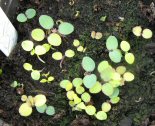 will
‘need’. You can remove out the green-leafed forms from
coloured
will
‘need’. You can remove out the green-leafed forms from
coloured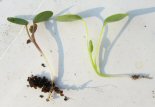 -leaf cultivars at this time.
The demonstration photos show firstly a mix of green and gold leaved
aquilegias, and then the selection of white flowered cultivars, where you select seedlings with no purple in their leaf stems. Prick out when large enough to handle (don’t leave too long as root growth is rapid).
-leaf cultivars at this time.
The demonstration photos show firstly a mix of green and gold leaved
aquilegias, and then the selection of white flowered cultivars, where you select seedlings with no purple in their leaf stems. Prick out when large enough to handle (don’t leave too long as root growth is rapid).
First soak the pot with water, then tip out the contents and tease seedlings apart from the edge of the compost ball. I even prick out at the seedling-leaf (cotyledon) stage sometimes. I place them directly where they are to grow on: either in nursery rows in the garden or in grow-bags.
Planting into flowering positions may be done at any time from autumn to spring before the flowering shoot appears. I have to pot each one up and keep until it flowers in May so that I know they are ‘true-to-type’ and can be correctly named and put into the collection.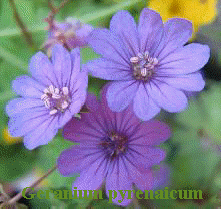
I grow a lot of hardy geraniums (cranesbills). You are unlikely to get many seeds in a packet so need to maximise those that do germinate. I sow in March. I’ve been told it’s important to remove the remains of the seed pod that may still be covering the seeds to increase germination rates. It can be hard to do so, but grinding against a metal sieve surface gives good results……so perhaps seed-donators can use this before sending to the exchange.
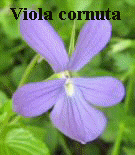 As a final example of sowing I’ll list a few great perennials that should flower the first year from seed if you sow early enough. That should be incentive enough!
As a final example of sowing I’ll list a few great perennials that should flower the first year from seed if you sow early enough. That should be incentive enough! 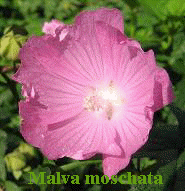 They’ll be pretty poor specimens the first year, but enough to encourage. Geranium pyrenicum (small but loads of flowers over a long period) will flower in about 3-4 months from a March sowing, whereas Geranium ‘Buxton Blue’ will take until early autumn. Small violas and pansies, of course, also take about 3 months to flower, but so does the lovely perennial Viola cornuta (horned violet).
They’ll be pretty poor specimens the first year, but enough to encourage. Geranium pyrenicum (small but loads of flowers over a long period) will flower in about 3-4 months from a March sowing, whereas Geranium ‘Buxton Blue’ will take until early autumn. Small violas and pansies, of course, also take about 3 months to flower, but so does the lovely perennial Viola cornuta (horned violet).
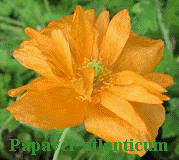 March sowing will also yield flowering plants in late summer of the white or pink musk mallow (Malva moschata); the yellow daisies of Buphthalmum salicifolium; the orange poppy Papaver atlanticum (syn
P. rupifragum), which is even better in it’s double form; and the tall elegant 5’ flowering
March sowing will also yield flowering plants in late summer of the white or pink musk mallow (Malva moschata); the yellow daisies of Buphthalmum salicifolium; the orange poppy Papaver atlanticum (syn
P. rupifragum), which is even better in it’s double form; and the tall elegant 5’ flowering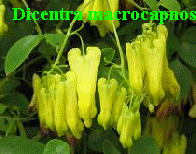 grass Pennisetum macrourum. There’s also a couple of climbers that’ll flower the first year….passionflower (Passiflora caerula) will need starting off indoors in the warm in February and growing under glass until about June to ensure flowering in Aug/Sept, and yellow Dicentra macrocapnos will respond to similar treatment. I’m finding more and more plants that can flower the first year that they are sown, and would gladly know of others. What plants have other members grown in this way?
grass Pennisetum macrourum. There’s also a couple of climbers that’ll flower the first year….passionflower (Passiflora caerula) will need starting off indoors in the warm in February and growing under glass until about June to ensure flowering in Aug/Sept, and yellow Dicentra macrocapnos will respond to similar treatment. I’m finding more and more plants that can flower the first year that they are sown, and would gladly know of others. What plants have other members grown in this way?
I hope I have encouraged some of you to sow seeds and given new ideas to those of you
 already besotted like I am to the wonders of germination. Please don’t let a few failures put you off….there’ll be many more successes. But perhaps I should also mention that although you may give some special seeds their EXACT requirements that you’ve looked up in a book, you may still fail from time to time. And it may not be your fault at all, but how the seed has been harvested, handled and stored before it gets to you. Sometimes such procedures drive the seeds into an extremely deep state of dormancy that cannot be broken. Botanists (of course) have a special term for this phenomenon: they say the seed is dead! Happy sowing!
already besotted like I am to the wonders of germination. Please don’t let a few failures put you off….there’ll be many more successes. But perhaps I should also mention that although you may give some special seeds their EXACT requirements that you’ve looked up in a book, you may still fail from time to time. And it may not be your fault at all, but how the seed has been harvested, handled and stored before it gets to you. Sometimes such procedures drive the seeds into an extremely deep state of dormancy that cannot be broken. Botanists (of course) have a special term for this phenomenon: they say the seed is dead! Happy sowing!
| Back to top |
| More articles |
| Home | Seed-List | Aquilegias | Plants & Seedlings | Video | Contact me |
| Talks | Sowing | Gardening | Garden Visits | Labels | Order forms |
| Smudge | Articles | Essences | Greeting Cards | Healing | Links |
